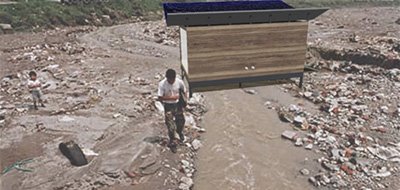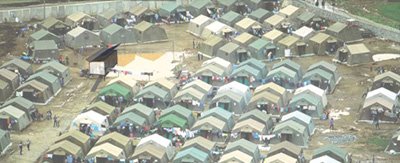DIY infrastructure

John Dwyer, an architect in Minneapolis, has designed a self-reliant housing structure that could have a wide reach of potential use all over the world, from disaster recovery to urban slum upgrades, remote refugee facilities, to needed supply of effective relief housing. More specifically, The Clean Hub, as it is called, is meant to function in places where basic infrastructure considerably lacks.
A recent article in Utne describes the 10- by 20-foot prefabricated unit as having “a V-shaped metal roof that collects rainwater and an adjustable array of 16 photovoltaic panels that can generate up to 2,640 watts of electricity. A reverse-osmosis system cleans water stored in a below-ground reservoir, where the gray water from showers and sinks is recycled. The toilets are waterless and self-composting. The building itself has impact-resistant stress-skin walls and secure entry doors, supported by a steel tube and a concrete-pier foundation that can adjust to sloped terrain and poor soil.”

Sounds great. Ironically, these type of self-sufficiency principles are something I wish more suburban McMansions used to base their models on.
Though, while I think it is clever and useful to design structures which are able to operate independently of a larger infrastructure, wouldn’t it be more valuable to come up with a solution which serves as an impetus for improving the more systemic issues of the Third World landscape rather than foregoing the challenge of infrastructure for more micro-self-dependent alternatives? And, while it is certainly intelligent to lessen reliance on public infrastructure (when it is in such a failed state) I wonder, will it only delay improvements to sewage and electricity that are needed on a massive scale? I'm not discounting this project in any way, just trying to understand how to address the longer range problems through even short term models, and what impact those temporary solutions will have in achieving a more comprehensive set of goals.

In other words, how can new housing models not only bring upgraded forms of shelter supply to the effected landscape, but also help play into a larger strategy of establishing more permanent and sustainable resolution to infrastructure in desperate communities, hoping for more significant planning change? Dwyer says, “The Clean Hub can serve temporary settlements such as refugee camps, but its 30-year life span makes it most suitable for semipermanent slums that lack basic infrastructure.” But, again, shouldn’t we be trying to accept slums as permanent (not the quality of their physical states, but their location and hopes to secure their own land rights status)? Therefore, shouldn't we be trying to improve these constructs for the long term? Are these housing units transportable, so, in the case of a slum clearance they would not be lost? Don’t the slums need more fixed solutions, that can help them improve their chances of permanence rather than accommodating the transitory nature of slum clearance policies?

Nevertheless, it is an encouraging project, and an important reminder that architects do have a crucial role to play in helping impoverished communities to improve their own conditions. Dwyer’s firm Shelter Architecture worked closely with the Minnesota chapter of Architecture for Humanity to consider the challenges, and hope to build a prototype that will eventually be able to make in roads to achieving the UN’s Millennium Development Goals, which call for significantly improving the lives of at least 100 million of the world's 1 billion slum dwellers by 2020.
Here is a short interview with John Dwyer from last year. And check out the AFH-MN blog, Blog Like You Give a Damn, which is running a good 13-part series on the Tsunami reconstruction landscape.







3 Comments:
Great questions. The Utne article is actually a reprint of an article that ran in Architecture Minnesota magazine about a year ago. Since that time, the Clean Hub has undergone some major design development dealing with many of the questions you raise. Essentially we have designed the Hub around the Cities Alliance's seven principles for urban slum upgrading, one of which is, obviously, land tenure. Out of that has come a scalable, adaptable design and delivery system that integrates local labor and local investors. All of these have become the real key pieces to long term sustainable development.
Thanks for taking an interest in the Hub. Please keep the good thoughts coming. They'll only make our efforts stronger. And keep in touch as many exciting developments are in the works.
Hi John,
Excellent. Sorry, though, I didn't realize this was such an outdated article. Nevertheless, sounds like the project is progressing, and in a more sustainable long term direction for the residents. Definitely keep me posted, very curious to see how this turns out, and gets implemented.
Land tenure, more so than housing itself, is probably the biggest challenge and greatest aspect we could help them attain. So, glad to hear the Clean Hub is helping more to guide that process.
If the archietcture could somehow ignite a change in policy in these places, isn't that the greatest tool we could help provide?: arch/shelter as retooling of land rights policy. The Hub then becomes a "hub" for much more than just housing and infrastructure, but, yeah, community building, policy recnostitution, or something.
anyway, forward me any new developments, since i am obviously very into seeing this type of project reach its potential.
we may all be living in The Clean Hub one day.
Bryan
I think the problems that California had with centralized power, along with the blackout of most of the Northeast has proven the vulnerabilities of centralized basic services. Alternatively, why spend the massive amounts to create a vulnerable system, AND, whilst our own centralized systems are aging and we are having problems servicing them, wouldn't it be very valuable to take as much of a load off the system as possible, in order to safeguard it?
Post a Comment
<< Home